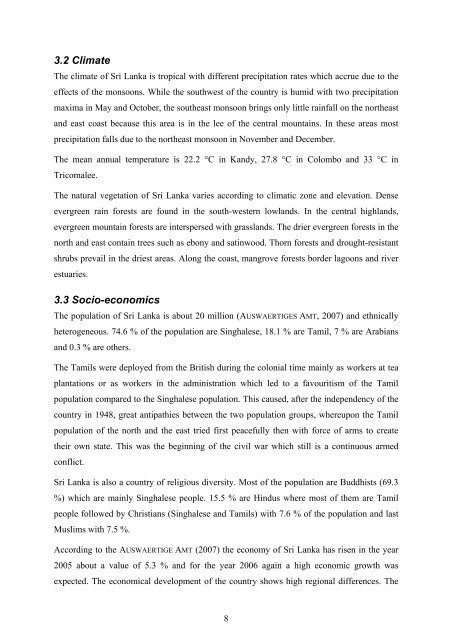Botryodiplodia sp. - Crops for the Future
Botryodiplodia sp. - Crops for the Future
Botryodiplodia sp. - Crops for the Future
Create successful ePaper yourself
Turn your PDF publications into a flip-book with our unique Google optimized e-Paper software.
3.2 Climate<br />
The climate of Sri Lanka is tropical with different precipitation rates which accrue due to <strong>the</strong><br />
effects of <strong>the</strong> monsoons. While <strong>the</strong> southwest of <strong>the</strong> country is humid with two precipitation<br />
maxima in May and October, <strong>the</strong> sou<strong>the</strong>ast monsoon brings only little rainfall on <strong>the</strong> nor<strong>the</strong>ast<br />
and east coast because this area is in <strong>the</strong> lee of <strong>the</strong> central mountains. In <strong>the</strong>se areas most<br />
precipitation falls due to <strong>the</strong> nor<strong>the</strong>ast monsoon in November and December.<br />
The mean annual temperature is 22.2 °C in Kandy, 27.8 °C in Colombo and 33 °C in<br />
Tricomalee.<br />
The natural vegetation of Sri Lanka varies according to climatic zone and elevation. Dense<br />
evergreen rain <strong>for</strong>ests are found in <strong>the</strong> south-western lowlands. In <strong>the</strong> central highlands,<br />
evergreen mountain <strong>for</strong>ests are inter<strong>sp</strong>ersed with grasslands. The drier evergreen <strong>for</strong>ests in <strong>the</strong><br />
north and east contain trees such as ebony and satinwood. Thorn <strong>for</strong>ests and drought-resistant<br />
shrubs prevail in <strong>the</strong> driest areas. Along <strong>the</strong> coast, mangrove <strong>for</strong>ests border lagoons and river<br />
estuaries.<br />
3.3 Socio-economics<br />
The population of Sri Lanka is about 20 million (AUSWAERTIGES AMT, 2007) and ethnically<br />
heterogeneous. 74.6 % of <strong>the</strong> population are Singhalese, 18.1 % are Tamil, 7 % are Arabians<br />
and 0.3 % are o<strong>the</strong>rs.<br />
The Tamils were deployed from <strong>the</strong> British during <strong>the</strong> colonial time mainly as workers at tea<br />
plantations or as workers in <strong>the</strong> administration which led to a favouritism of <strong>the</strong> Tamil<br />
population compared to <strong>the</strong> Singhalese population. This caused, after <strong>the</strong> independency of <strong>the</strong><br />
country in 1948, great antipathies between <strong>the</strong> two population groups, whereupon <strong>the</strong> Tamil<br />
population of <strong>the</strong> north and <strong>the</strong> east tried first peacefully <strong>the</strong>n with <strong>for</strong>ce of arms to create<br />
<strong>the</strong>ir own state. This was <strong>the</strong> beginning of <strong>the</strong> civil war which still is a continuous armed<br />
conflict.<br />
Sri Lanka is also a country of religious diversity. Most of <strong>the</strong> population are Buddhists (69.3<br />
%) which are mainly Singhalese people. 15.5 % are Hindus where most of <strong>the</strong>m are Tamil<br />
people followed by Christians (Singhalese and Tamils) with 7.6 % of <strong>the</strong> population and last<br />
Muslims with 7.5 %.<br />
According to <strong>the</strong> AUSWAERTIGE AMT (2007) <strong>the</strong> economy of Sri Lanka has risen in <strong>the</strong> year<br />
2005 about a value of 5.3 % and <strong>for</strong> <strong>the</strong> year 2006 again a high economic growth was<br />
expected. The economical development of <strong>the</strong> country shows high regional differences. The<br />
8

















